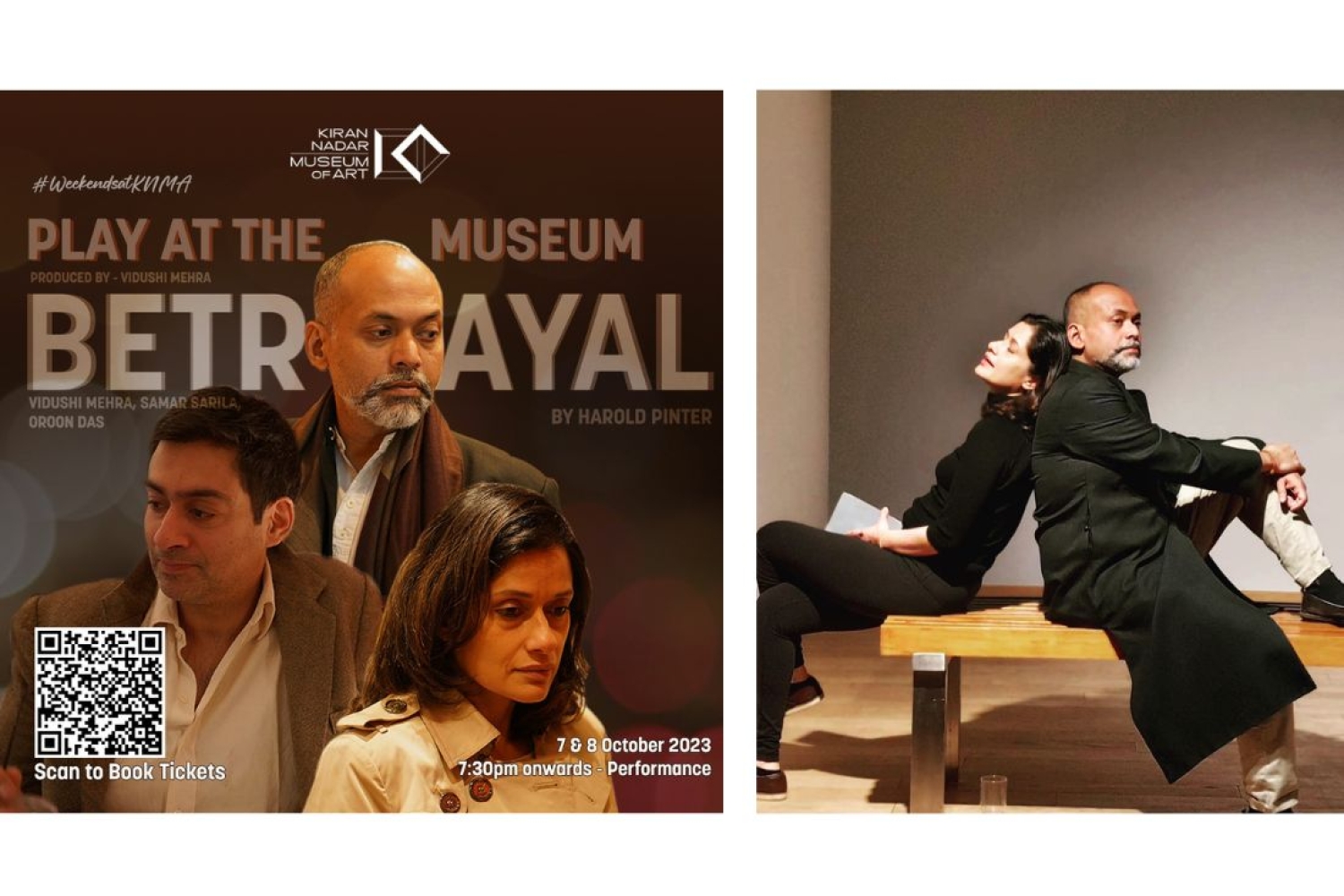

Harold Pinter's Betrayal is a celebrated play that delves into the complexity of human desires. While the play features only three characters and minimal props, its excellence lies in its words, dialogues, and the emotions it evokes. Emma, Jerry, and Robert find themselves entangled in extramarital affairs and unhappy marriages. However, they refrain from breaking these relationships due to their co-dependency on each other. They find themselves lost in the loop of seeking constant satisfaction and contentment. As they rehearsed for their upcoming performances at Kiran Nadar Museum of Art on October 7 & 8, I sit down with the three actors, Vidusshi Mehra (Emma), Samar Sarila (Jerry), and Oroon Das (Robert), to explore the intricacies of their characters and their approach to adapting the play.
Why did you choose a space like an art gallery to showcase your play?
Vidusshi: I think the museum makes sense in many ways. One reason is that theatre is not a far-removed idea from art. It is about time, where different art forms collaborate and showcase the best of each other. We felt the museum could do that for us. It's a good marriage. It's not necessarily a large, fascinating environment but an intimate audience with an intimate cast, which is important for us. Also, in the background of our stage, you can see this artwork made of soaps, which has broken pieces. It blends well with the essence of our play and the broken-ness of its characters.
Samar: I find museums can be very lonely spaces. Everyone is in their heads. They are in their pensive moods. A lot of people come to galleries alone to relieve their anxieties or to seek something, so it also reflects the utter loneliness of the characters in the play.
The play runs forward and then backward. How does this mingling of time help portray the relationships between the characters?
Vidusshi: The play is written in nine parts; three of them move forward in time, but the rest of the narrative is backward. I think Pinter tries to explore the characters' lives before the affair, during the affair, and what happens after it.
Samar: Another important aspect we discussed is that even though the play moves backward, the idiosyncratic characteristics of the characters remain consistent. In a play that progresses linearly, you can explore certain character traits, but for actors to play the characters who are moving backward, is challenging. So, even at the end of the play, I have the same habits as at the beginning.
Now, because all the characters are lonely in some way or another, is that the reason they are also co-dependent and unable to leave each other?
Oroon: Yes, they are locked in. That's a very keen observation. I hadn't thought about it, but when you put it that way, it makes sense. You can become accustomed to your misery, to the certainty of it. It feels like we would rather stick with misery than keep ourselves open to the uncertainty of the future.
Vidusshi: For some people, the uncertainty of the future is worse than the present. I am aware of what I'm dealing with now, but who knows what will happen tomorrow, right? Especially in the Indian context, you rarely see one of the two partners decide to end an unhappy marriage. Being unhappy in a marriage is considered a sin, something we have to endure. It's considered shameful to disclose the reasons for unhappiness in a marriage. Look at Emma, for example; she can never be satisfied. She wants a combination of different qualities from one man—Robert's stability, Jerry's love and the mysterious nature of Spinks. But you can't find all of that in one person. So, she is constantly chasing an idea that doesn't exist. She sets herself up with so many different expectations of love, but that's true for most of us. We want to bring out this aspect.
Oroon: The play is actually quite typical in terms of the existential crisis you see in literature from the 1970s. Personally, it took me some time to delve into the text of the play and enjoy it. When you're involved in it, it can be quite intriguing how Pinter builds in very ambiguous intentions among the three characters. It becomes challenging to judge one or the other. You find yourself taking one person's side and then shifting positions, feeling empathy for another. That's Pinter's genius.
What did you guys discover through the exploration of this play?
Oroon: The play is important because it delves into deep urban dissatisfaction. I emphasize the word 'urban' because it's set in early 1970s London, which was supposedly quite progressive. The art and literature of that time were a common currency, not reserved for a slim elite. Yet, there is a profound dissatisfaction with one's situation, regardless of what your life holds. These three characters are fairly well-off; there isn't any serious deprivation. I think the play is significant for that reason, and it's highly relatable. Despite education, professional practice, and the ability to make sense of the world, why do we struggle to find happiness and contentment? Pinter's characterization is very layered, making his plays interesting.
Words Paridhi Badgotri
Date 06.10.2023